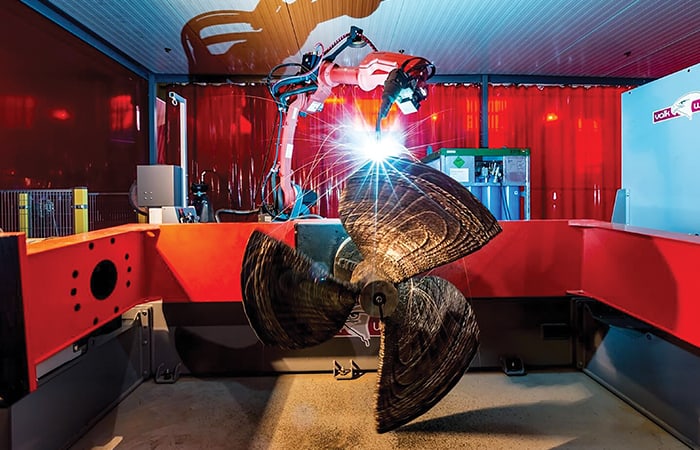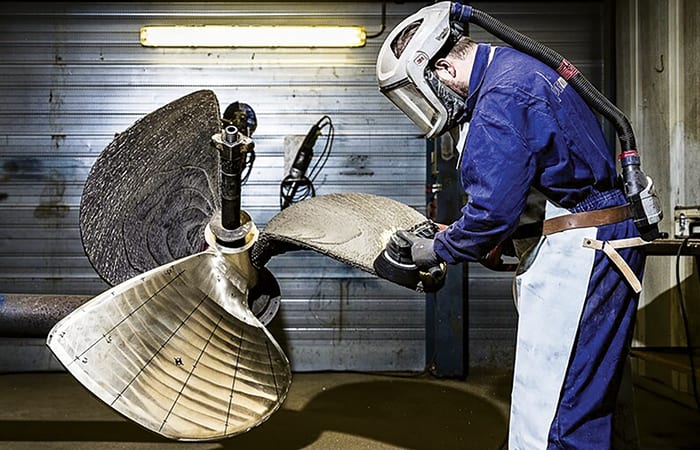Over the past few years, firsts in additive manufacture have been coming thick and fast. But with the technique well suited to making small structures with complex geometries, these first tend to be components which play to its strengths. They are small, often optimised to cope with specific mechanical stresses and pared down so they only have material where they need it most, so they are often skeletal in appearance. Waampeller is very different.

The first fully certified marine propeller to be made by additive manufacturing, Waampeller was recently unveiled in Rotterdam, installed on the type of tug that works the city’s docks. It measures 1.3m across, weighs 180kg, and does not have the pared-down structure common to many additive parts; indeed, an observer would find it difficult to distinguish it from any other propeller.
The propeller was made at RAMLAB (Rotterdam Additive Manufacturing Laboratory) as part of a collaboration involving marine constructor Damen Shipyards Group, manufacturing software firm Autodesk, Dutch propeller and marine technology specialist Promarin, Port of Rotterdam (one of RAMLAB’s owners) and the Dutch marine testing, inspection and certification house Bureau Veritas. Its name comes from the specific additive process that was used to build it – wire-arc additive manufacturing. This is essentially a form of welding, where an electric arc is used to melt and then deposit a metal welding wire in a continuous fashion; it is often used to build cylindrical or conical structures, with the printing head depositing a continuous helix of metal that builds up.

Waam is one of the fastest additive methods currently in use, depositing tens of grammes of material per minute rather than the milligramme or microgramme per minute rates of powder-bed additive. Moreover, it is not confined to the small volumes of conventional 3D printing machinery as it can be integrated with robotics. The printing head is installed as an end-effector on the type of robot arm whose use has become well established in many fields of manufacturing.
The Waampeller was unveiled after it had successfully completed sea trials on the Damen sea tug, involving tests such as speed trials, a bollard pull and a crash stop going from full forward to full reverse thrust. This resulted in the component being awarded full type approval by Bureau Veritas. “One of the most exciting things about this project is that we have not just produced a one-off demonstrator. It’s relatively easy to do something once, but to produce a certified part and establish a process takes more time and consideration. Working with a great team of partners, we’ve harnessed the best of additive and subtractive manufacturing to create a process that is repeatable. This repeatability provides the potential to radically transform the whole industry,” said Kelvin Hamilton, senior technical consultant at Autodesk, who was involved in the project from beginning to end.
It was Hamilton’s inspiration that kicked off the whole project. “I thought a propeller would be an intriguing geometry to tackle with additive manufacturing; it has complex curves and has to endure severe stresses in service, “ he told The Engineer. “I built one as an exercise at Autodesk in Birmingham, and Damen happened to see it and decided to take the project further.”
The design of the Waampeller is one of Promarin’s standard propellers, and Port of Rotterdam then got RAMLAB involved.
Based in a small, screened-off area of a cavernous former submarine factory in Rotterdam’s docks, RAMLAB shares space with a large number of other small technology operations. Pride of place in its cramped premises go to two Waam-equipped robots. The acquisition of these was guided by a collaboration with the Waamlab at Cranfield University, explained RAMLAB co-founder and managing director Vincent Wegener. “Cranfield is focused much more on aerospace applications, but they were very helpful when it came to us making our investment decision, “ he said.
Four versions of the Waampeller were made; the first in mild steel to help design the construction strategy – the path that the welding head took to build up the structure onto the cylindrical propeller shaft; the second in stainless steel, and a prototype in the final construction material of nickel aluminium bronze alloy. This is a standard material for propellers, Hamilton said. “We would normally cast them, but it isn’t normally available as a welding wire so that had to be custom-made.”
The Waam process creates a deeply ridged surface, so the propeller has to be ground down to create the smooth surface needed for its operation. The prototype was finished by CNC Milling, but the actual final article was ground by hand in a process that took three days. “The castings are generally hand-ground, so for the purposes of certification we wanted to keep one part of the manufacturing process the same; everything else is different,” Hamilton added.
The propeller is built from 298 layers of bronze, deposited over 256 hours. “Production of the second Waampeller was greatly improved because we had learned a lot from producing the prototype,” says Wegener “This mainly concerned the hardware/software interaction because, when laying down 298 layers of nickel aluminium bronze alloy, it is important to have a tight control on all process parameters.”
The shape of the molten metal bead deposited by the welding head is particularly important, and testing had to take into account the effects of anisotropy. Characteristic of materials built up in layers, this is a variation in physical properties depending on the direction through the material; cast metals are isotropic, with the same properties in all directions.
“We know welds are strong, and Waam essentially makes a single continuous weld, so we thought it would be OK, but we still had to prove it,” Hamilton said. “We did the entire manufacture for this item, but I think its real strength will come in maintenance; if a propeller is damaged, for example, a piece gets knocked out of a blade or a blade gets deformed, we will be able to grind away the damaged part and print directly on top to reform it. That will be much faster and cheaper, and potentially stronger too.”
Another potential advantage, Wegener said, is that Waam produces hollow parts. “If you print a hollow propeller blade, it will be lighter, so the boat will burn less fuel to turn it,’ he said. “Also, you have the opportunity to incorporate strain sensors directly into the structure as you are printing, which could give you advance warning of failure.
Read more about additive manufacture here




IEA report claims batteries are ‘changing the game’
It is important in trucks and other commercial vehicles as the payload will be reduced if the battery weight is penal. Battery applications in the...